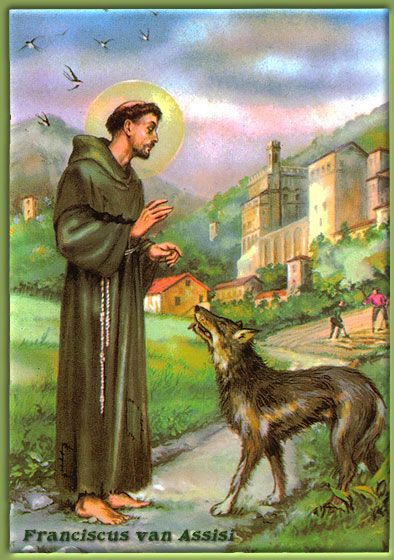
St. Francis of Assisi was born in the year 1182, son of Pietro di Bernardone, and the lady Pica. At Francis’s birth, his father was away on a business trip to France, and his mother had him baptized as Giovanni. On his return Pietro changed the infant’s name to Francesco. In 1202 he took part in a war between Assisi and Perugia, was held prisoner for almost a year and on his release fell seriously ill. After his recovery, he attempted to join the papal forces. On his journey, he had a vision that made him return to Assisi and await the call to a new kind of knighthood. On his return, he dedicated himself to solitude and prayer so that he might know God’s will for him.St Francis died on the evening of October 3, 1226.He was canonized on July 16th, 1228. In 1979 Pope John Paul II recognized him as the patron saint of Ecology. We celebrate his feast on the 4th of October every year.
He is the Founder of the Franciscan orders of the Friars Minor, the women’s Order of St. Clare (the Poor Clares), and the lay Third Order. His evangelical zeal, consecration to poverty, charity, and personal charisma drew thousands of followers. Francis’s devotion to the human Jesus and his desire to follow Jesus’ example reflected and reinforced important developments in medieval spirituality.Francis renounced worldly goods and family ties to embrace a life of poverty. The saint was a lover of nature, a social worker, an itinerant preacher, and a celebrant of poverty Francis considered all nature as the mirror of God. He called all creatures his “brothers” and “sisters.
He preached to the birds and persuaded a wolf to stop attacking the people of the town of Gubbio and their livestock if the townspeople agreed to feed the wolf. In his “Canticle of the Creatures” he referred to “Brother Sun” and “Sister Moon,” the wind and water, and even “Sister Death.” He nicknamed his long and painful illnesses his “sisters,” and he begged pardon of “Brother Ass the body” for having unduly burdened him with his penances. Above all, his deep sense of brotherhood under God embraced his fellow men, for “he considered himself no friend of Christ if he did not cherish those for whom Christ died. “It was during this period that St. Francis had a mystical vision of a dilapidated church. The Icon of Christ Crucified said to him, “Francis, Francis, go and repair My house which, as you can see, is falling into ruins”. He repaired the church of San Damiano, refurbished a chapel dedicated to St. Peter the Apostle, and then restored the little chapel of St. Mary of the Angels Portiuncula
This mission gave Francis a clear mission in life and he embraced a life of poverty, chastity and devotion to Jesus Christ. He spent much of his time in prayer and meditation. Gradually, he began to attract other young men, by his spiritual fervor and renunciation.

